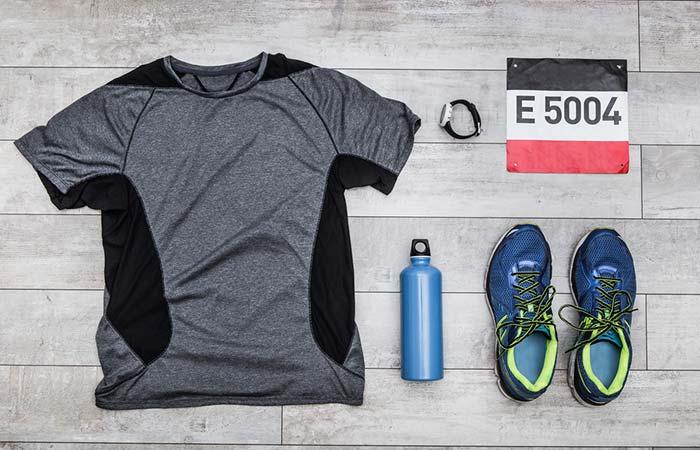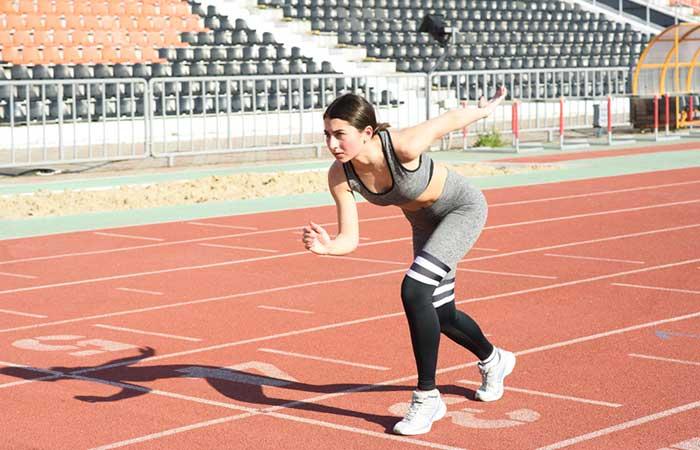Running comes naturally to us humans. In today’s world, as we have developed multiple modes of transport for travel, running has evolved into a popular form of exercise. It provides numerous health benefits.
It aids weight loss, strengthens joints, and promotes endurance (1). The best way to avail these benefits is to run, of course.
But how do you run? How do you start? What is the right way to go about it? Find answers to these questions in this article.
How To Start Running
Following are a few tips to help you get started:
1. Get Motivated
Motivation comes to different people from different sources. One needs to identify what motivates them and set that factor in place. The following pointers can help one stay motivated to run regularly:
- Watching & reading motivational fitness stories.
- Setting weekly or monthly short-term progression goals and achieving them. Long-term goals can also help one strive to achieve them.
- Getting a running partner who pushes you to run regularly.
- Selecting the ideal environment for running. These include proper gear, music, etc.
The motivating factors can vary from person to person. But as seasoned runners often say, motivation is overrated, discipline is the key.
2. Find Your Place
Choose the right place in accordance with your goals, safety, and suitability. A city inhabitant may choose to run on roads/tracks on regular days and take up trail running on weekends.
3. Warm-Up
It is recommended to do a proper warm-up routine before hitting full intensity. A dynamic warm-up routine gets the heart and blood circulation going, sets up the muscles for better performance, and reduces chances of injuries or breakdown (2).
Warm-up exercises could include brisk walking, bodyweight squats, spot jumps, high knees, intermittent runs, etc.
4. Start With The Run-Walk Method
The Run-Walk method is ideal for someone who has not run for a long time. It involves intermittent periods of walking and running.
For example, you can begin by walking for 90 seconds, followed by running for 60 seconds. Keep alternating.
5. Use Proper Running Form
People often get injured due to an improper running form. Following these pointers can help you avoid that:
- Keep your body relaxed and upright with a stable posture. There should be no rigidness anywhere. Keep your ankles locked, and knees slightly bent.
- Keep your head upright with your eyes focusing straight ahead.
- Take short strides that land at the center of the body’s mass with your mid-foot striking the ground first (and not your toe or the heel). This helps the body effectively use the legs’ spring mechanism.
- Keep your chest outwards and shoulders upright.
- Your arms must form a 90-degree angle at the elbows. They must move close to the body.
As you run regularly, your muscle memory makes it easier for you. You will reach a point where you do not have to put a conscious mental effort into running. A proper running form also ensures better performance by enhancing the running economy (3).
6. Run Longer
Long-distance steady-state running helps build immense stamina. Such runs need tremendous physical endurance, mental strength, and aerobic capacity. Long-distance running is mostly done at 60%-80% of the aerobic capacity. Running long distances regularly helps improve these variables (4), (5).
7. Get Faster
Running fast and being able to cover long distances helps build explosive power. Such runs need tremendous agility, cadence, acceleration, and aerobic capacity. Fast running is usually done at 80%-95% of aerobic capacity with quick, short strides. Faster runs help improve aerobic capacity tremendously (6).
8. Pick A Race
Set your sights on an upcoming race event. Whether you enjoy steady-state running or racing, participating in race events will help you stay focused and consistent with your training and nutrition.
9. Set A Goal
A well-defined goal keeps one focused on achieving it. If you want to win a 5K run in the next 6 months, you obviously will train, eat, and think accordingly.
10. Pick Your Gear
Select the right kind of caps, shorts, underwear, tops, knee caps, socks, etc. for better motivation and improved performance.
- Choose The Right Shoes
Consider the terrain you want to run on and look for shoes that suit that terrain. Try out a few pairs in a store and run in them. Choose a pair you find comfortable to run in.
- Choose The Right Socks
Avoid cotton socks as they soak a lot of moisture and can also cause blisters on the feet. Synthetic blended socks made of nylon, lycra spandex, etc. with a thick sole padding work best.
- Choose Your Favorite Playlist
Preparing your favorite music playlist will keep you going during the runs. It will also make running more fun.
- Carry Timing Devices
Carrying digi-clocks or stopwatches will help you assess your performance and make improvements.
11. Fuel Your Body
Proper nutrition ensures optimal performance and reduces fatigue.
You must include complex carbohydrates in all your meals for a steady supply of energy. Consume proteins and fats in adequate quantities to ensure muscle health and recovery.
You can have fast-digesting carbs like bananas, glucose water, and oatmeal cookies for constant energy supply before, through, and post the run (7). Avoid spicy foods the night before the running day to prevent stomach upset.
You can also take protein or micronutrient supplementation. Even beetroot juice helps. It enhances running mechanics in runners (8).
You must have pre-, intra-, and post-run meals for better performance and recovery. Fast-absorbing proteins can be added to the post-run meal to ensure a quick replenishment of glycogen.
During the run, the body loses a lot of water and electrolytes through sweating. Hence, consume adequate amount of water before and during the run to avoid dehydration and fatigue.
This brings us to an important question.
Can You Run To Lose Weight?
To lose weight, one needs to be on a calorie deficit diet. Both steady-state running and racing consume a lot many calories. These add to the calorie deficit by increasing energy expenditure (9). Here are a few pointers:
- Count Your Calories Burned
Calories burned during the run would depend on a host of factors like the weight of the person, their aerobic capacity, the distance of the run, etc. Higher the aerobic capacity of the runner, fewer the calories burned. Keeping an estimated track of burned calories through fitness watches and other gadgets helps one in making improvements and diet planning.
- Avoid Runner’s Weight Gain
Running makes people feel very hungry. People often presume that since they are running a lot, they will not gain fat. This can lead to overeating, causing the runner’s weight gain. Keeping track of the calories burned while running and adjusting one’s diet accordingly can help one avoid the weight gain.
Different forms of running involve different muscle fibers, energy systems, techniques, strategy, and planning.
You might be wondering how you can start running if you are out of shape or overweight. Scroll down to the next sections to find the answers.
How To Start Running If You Are Overweight
If you are overweight and want to run to lose those pounds, you need to consider the strength of your lower body. Running with a heavy upper body puts stress on the lower body, causing issues like knee pain.
If that is likely to happen, it is better to start by losing weight with a calorie deficit diet, resistance training, and steady-state cycling. You can gradually transition to running after you lose some weight and have a decent muscle mass.
How To Start Running When You Are Out Of Shape
Going all out running when you are out of shape can cause discomfort in normal life and even lead to injuries. Build endurance, speed, and power in a step by step fashion. Remember, you want to make this a lifelong habit.
Where Can You Run
Running at a steady pace for longer distances is called jogging (or steady-state running), and running at a faster pace is called sprinting or racing. There are other types of running that we will look at now.
- Road Running
This is running on concrete/gravel roads, pavements, demarcated areas of the road, etc. for a fixed distance. Half marathons, marathons, etc. are examples of road running. Its main characteristic is the consistency of the surface. This makes it easier to run with steady strides without focusing on the terrain.
Some individuals believe running on concrete might hurt the knees. This is not true. In fact, it depends on a number of other factors like running form, underlying health issues, and nutrition.
- Treadmill Running
The treadmill has various features. These include variations in the speed of movement, slope, and consistency of the surface. You can change all of these with the click of a button. The machine moves at a set pace, and the runner has to concentrate consistently to match up to it.
Treadmill running can get monotonous with time.
- Racing
Racing is sprinting to cover a specific distance within a specific amount of time. It can be continuous or fragmented. The common types of racing competitions are 100, 200, 600, and 800 meters and relay racing. The sport is all about adrenaline and thrill.
- Trail Running
Trail running is done on natural terrain. This includes uphill/downhill slopes, muddy or rocky grounds, and an occasional encounter with a wild animal!
You need higher concentration due to the unpredictable terrain. If you are looking for adventure, trail running is the answer.
- Track Running
This involves running on synthetic tracks at sports facilities. These tracks are demarcated by white lines. These tracks can be used to practice running at all intensities. These tracks are safer and convenient compared to running on roads, etc.
Let’s now understand the basics of running. In case you have any health issue, please get a medical clearance from the doctor.
Choosing a proper training plan in alignment with your goals sets you up accomplishment.
How To Include Running In Your Workout Routine.
Sample 1-Week Plan For Beginners
A sample 1-week running plan for a beginner would look something like this:
| Day | Activity | Repetitions |
|---|---|---|
| 1 | Walking for 120 secs followed by running for 60 secs | 10 times |
| 2 | Rest | |
| 3 | Walking for 120 secs followed by running for 60 secs | 10 times |
| 4 | Resistance Training & HIIT:Squats Push-ups Spot Jumps/Skipping Jumping jacks | 3-4 sets of 10 -15 reps each |
| 5 | Rest | |
| 6 | Walking for 120 secs followed by running for 60 secs | 10 times |
| 7 | Rest |
Note: The running speed should be such that a person should be able to speak a proper sentence without struggling for breath.
Other Tips/ Recommendations
- Prevent Injury
Running injuries can happen due to excessive stress on the bones in the lower body, the joints, and muscles. Common injuries include stress fractures, joint issues, muscle tears, and sprains. Proper warm-up, stretches, and rest and recovery are essential to prevent injuries, including leg cramps.
- Incorporate Side Stretches In Your Routine
Post-run static stretching helps in cooling the body down, preventing injuries and muscle soreness. Doing side stretches can be a good idea.
- Don’t Overdress
The more you dress, the more weight you carry. With sweating, the clothes absorb more fluid and become heavier, causing discomfort during the run. Wear minimal clothing made of a material that does not absorb fluids.
- Do Strength Training
Strength training is imperative for any runner to develop explosive power to accelerate and maintain the tempo during runs (10), (11).
Moreover, strength training also reduces muscle loss (12).
Conclusion
Running is one of the best exercises to improve your cardiovascular, musculoskeletal, and respiratory health. It also is a tremendous recreational and social activity.
Over the ages, different forms of running have helped many to remain fit and healthy. However, like any other sport or exercise, one needs to run with proper form, methods, and a goal-oriented approach.
Do you run regularly? What changes did you see in your health? Do share your experiences with us by leaving a comment in the box below.
Expert’s Answers For Readers’ Questions
How far should you run?
This would depend on your current condition and goal. Start from 500 to 1000 meters and progress gradually.
How many times a week should I run to lose weight?
Two to three times a week is good enough. You can spend the other days on cross-training or resistance training.
References
- “Meta-Analyses of the Effects of Habitual Running on Indices of Health in Physically Inactive Adults” Sports Medicine, US National Library of Medicine, National Institutes of Health.
- “Acute Effects of Dynamic Stretching on Muscle Flexibility and Performance: An Analysis of the Current Literature” Sports Medicine, US National Library of Medicine, National Institutes of Health.
- “Running Technique is an Important Component of Running Economy and Performance” Medicine and Science in Sports and Exercise, US National Library of Medicine, National Institutes of Health.
- “Controlled Endurance Exercise Training and VO2max Changes in Older Adults: A Meta‐Analysis” Wiley Online Library.
- “A meta-analysis on the effects of exercise training on the VO2 max in children and adolescents” ResearchGate.
- “Effects of different protocols of high intensity interval training for VO2max improvements in adults: A meta-analysis of randomised controlled trials” ScienceDirect.
- “The effect of a high carbohydrate diet on running performance during a 30-km treadmill time trial” European Journal of Applied Physiology and Occupational Physiology, US National Library of Medicine, National Institutes of Health.
- “The effects of beetroot juice supplementation on exercise economy, rating of perceived exertion and running mechanics in elite distance runners: A double-blinded, randomized study” PloS One, US National Library of Medicine, National Institutes of Health.
- “The Effects of Exercise Training in Addition to Energy Restriction on Functional Capacities and Body Composition in Obese Adults during Weight Loss: A Systematic Review” PLOS Journals.
- “Increases in Lower-Body Strength Transfer Positively to Sprint Performance: A Systematic Review with Meta-Analysis” ResearchGate.
- “The Effects of Concurrent Strength and Endurance Training on Physical Fitness and Athletic Performance in Youth: A Systematic Review and Meta-Analysis” ResearchGate.
- “Effects of Strength Training on the Physiological Determinants of Middle- and Long-Distance Running Performance: A Systematic Review” Sports Medicine, US National Library of Medicine, National Institutes of Health.
The post How To Start Running appeared first on STYLECRAZE.
from STYLECRAZE https://ift.tt/2MisbtN
via IFTTT













No comments:
Post a Comment